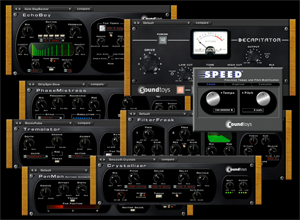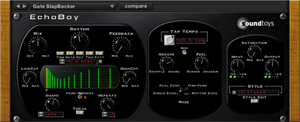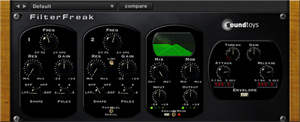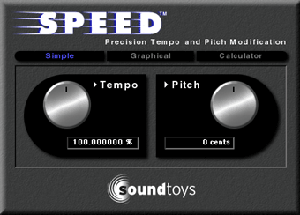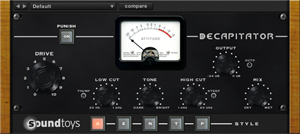SoundToys Native Effects Bundle Reviewed by Zach McNees
As a mix engineer, I’ve spent increasingly more and more time in front of my home rig in the last couple years and less time in front of big mixing consoles in studios stocked with outboard gear.
Because of this, it’s essential that the tools I’ve grown accustomed to in the racks of my favorite studios be available to me in software form to use on my mix projects. Enter: SoundToys’ Native Effects Bundle. For the past several years, SoundToys has been at the forefront of the revolution to accurately replicate many of the most recognized hardware FX units for use in the box.
TECH SPECS: The Native Effects bundle by SoundToys is a Native-only plug-in package for use on Mac and PC and retails for $495. It comes with installers for VST, AU, RTAS, and AudioSuite and is compatible with Pro Tools LE 7, 8 & 9, M-Powered, Digital Performer, Logic Pro, Cubase, Nuendo, Sonar and Live.
The bundle includes 8 plug-ins: EchoBoy, FilterFreak, PhaseMistress, Tremolator, Speed, Crystallizer, and the all new PanMan and Decapitator. All of these plug-ins work in the formats listed above except Speed which functions like many other pitch and manipulation as a non-real time AudioSuite- and Logic Pro Time Machine-compatible plug-in.
WHAT IT DOES: At the heart of the Native Effects Bundle are the six most popular and widely used plug-ins in the SoundToys family — EchoBoy, FilterFreak, PhaseMistress, Tremolator, Speed and Crystallizer. These plug-ins have become a gold standard in effects and manipulation tools for many mixing and audio engineers over the last six years. The two new additions to the bundle are the Decapitator, an analog saturation modeler, and the PanMan, a rhythmic auto-panner.
SoundToys plug-ins are deep with complex functionality and intricate features that will keep the pros busy for hours. For those who may not be as technically inclined or experienced as mixers, not to worry — SoundToys plug-ins feature a huge array of presets that will allow even first time users to find the sound they’re looking for quickly and easily.
A great example of this is the ability to sync time-based FX to the MIDI tempo of your session and adjust the timing properties of the effect musically such as ¼ note and 1/8th note. Hugely helpful to those who are more musically than technically inclined.
THE INTERFACE: All of the SoundToys plug-ins except Speed have a very simple white on black design with clearly labeled controls and switches. While all of the plug-ins in the bundle are packed with features, none of the individual units feel overly crowded or difficult to process visually which is refreshing.
IN USE: One of the great things about SoundToys plug-ins is their ability to accurately emulate some of the things we love about our analog gear. A simple example of this would be the input and output control sections, which — just like their hardware counterparts — allow for easy gain staging and gentle overall adjustments to your effects. This is particularly useful when you want to gently overdrive a particular effect or conversely to back off a bit.
ECHOBOY is the flagship processor in the SoundToys family and doesn’t disappoint in its wide array of uses. This plug-in alone boasts over 30 different built-in echo styles with instant access to a wide variety of classic delay and echo boxes including EchoPlex, Space Echo, Memory Man, DM-2, and the TelRay oilcan delay.
Along with standard echo functions like Time, Feedback and Low/High Cut, EchoBoy boasts Tap Tempo, MIDI Sync, knob adjustments for groove and feel, and an adjustable saturation knob in the input section to give your echo effect an extra boost. The most remarkable thing about EchoBoy is simply how unique each of their delay styles sound and how strikingly similar they are to the hardware that they are meant to emulate.
Excellent examples of this are the rolled-off and warm Echoplex, creamy-smooth Space Echo and Tel Ray and the hi-fi sound of studio tape. For the technically inclined, Echoboy — along with a number of other plug-ins in this bundle — includes a few extras: i.e. a switch called Prime Numbers on the EchoBoy keeps the repeating echoes from building up resonance that often occurs when every repeat is at exactly the same time interval. This is a big help for engineers who’ve found themselves reaching for a post-FX EQ to alleviate some of the frequency build up from vocal or guitar echoes that resonate within the key of the song.
CRYSTALLIZER is a wild FX unit inspired by the Crystal Echoes presets in the Eventide H3000. Crystallizer does everything from off-the-wall harmonizing and octave treatment to backwards FX as well as more traditional chorus and reverb.
The main controls on the front face of Crystallizer include Input and Output, Dry/Wet Mix, Pitch, Splice, Delay, and Recycle. Pitch allows you to drastically raise and lower the pitch of the effected signal. The Splice control determines the length of the section of audio being sent to the unit that is captured and played back and at what speed it’s played back.
For example, according to the Crystallizer manual, if you set the Splice control to 1000ms it will be looking to grab a slice of audio every 1000ms and there will be approximately a 1000ms (1 second) delay before the effect sound is played back. Delay adjusts the amount of delay time added to the signal. Recycle is a kind of feedback control and allows you to send the output of the effect signal back into the input at varying amounts.
As with most of the SoundToys plug-ins, Crystallizer is much more easily digested with your ears than your eyes. More than anything else, you will need ample time to experiment when using Crystallizer to find the settings that work best for the given application. Settings for Drums, Echo (pitch and reverse), Guitar and Keys, Harmonizes, Melodic, and Spaced Out will help guide you quickly in a general direction.
FILTERFREAK is a resonant analog filter. Familiar controls for Mix, Frequency, and Resonance are joined by “Mod,” a control used to adjust the overall depth or amount of modulation applied to the filter’s frequency. Some of the excellent presets in FilterFreak include: Basic Filters and Modulation, Bass, Drum Destruction and Mangling, Envelope Filters, FX, Guitar, and Sweeps.
I tried FilterFreak as a wah-type sound on electric guitars. The results are as close as I’ve been able to come to an actual wah pedal in a plug-in and it has proven its worth a number of times on electric guitars and keys. In fact, I’ve gotten in the habit of recording these types of tracks in the studio dry knowing that I have the option of adding wah with FilterFreak later in mixing.
FilterFreak is not a subtle plug-in, but one that can be used across a wide variety of instruments to create a new sonic landscape that what was perhaps originally intended. FilterFreak tends to find its way into my mix sessions most often with artists that are looking for the mix engineer to add another level of creativity to the project musically as well as provide a sound mix.
PHASEMISTRESS is the mother of all analog phasers. Nearly every classic phaser imaginable was tested exhaustively in the design of the PhaseMistress and it shows. Controls for Mix, Frequency, Resonance, Mod and Rate are standard across the front along with input and output controls.
Like its counterparts in the Native Bundle, PhaseMistress boast a uniquely impressive sound and can be tweaked extensively to dial very specific settings. When I was messing with it, I managed to dial in the perfect Smashing Pumpkins-style phaser sound for an electric guitar. PhaseMistress is by far my favorite go to plug-in for all phaser needs be it guitars, keys, subtle or not so subtle drum FX and much more.
TREMOLATOR seems to me to be by far the best and most extensive Tremolo plug-in available. Controls for Depth, Groove, Accent and Rate provide all the necessary tools of the Tremolo sound. A wealth of excellent presets to choose from including emulations of the classics like Dan Electro, Demeter, Fender, Premier, SilverTone and Wurlitzer are also available to point you in a familiar direction.
Tremolator also morphs into a very cool auto-gate when the shape pulldown is switched to square wave. Engage the MIDI switch and you have an instant time-locked auto gate that can prove to be very handy on guitars, keys and other instruments. For guitars that need a little soul and keys that were cut totally dry, Tremolator is a life-saver and has become my go to plug-in for adding that little extra depth to my rhythm tracks.
SPEED is the AudioSuite- and Logic Pro Time Machine-compatible pitch and tempo modulation plug-in from SoundToys. You have the option of Simple, Graphical and Calculator modes to help you either stretch your audio or alter its pitch.
When I used Speed on delicate vocal and bass guitar tracks, it performed better than expected with very little destructive artifacting to the original signal even when the tempo or pitch were pulled down significantly. Like other SoundToys plug-ins, Speed is straightforward, but produces results you’d expect out of a more complex chain.
Last but certainly not least are the new additions to the SoundToys Native Effects bundle. The Decapitator and PanMan are welcome additions to an already impressive lineup of staple Pro Tools plug-ins for many engineers.
PANMAN is a rhythmic auto panner that bears more than a striking resemblance to the classic old PanScan found in the big classic recording studios. SoundToys jokes that PanMan serves all your panning needs that you didn’t know you had and they’re right. While an auto panner might not be first on anyone’s list of day-to-day plug-in necessities, the PanMan has some very handy features and functionality for which I found a number of uses. Keys, guitars and vocals, for example, can all benefit from the subtle tremolo-like effects of this ”set it and forget it”- style auto panning tool.
PanMan’s basic controls are: Offset, which allows you to focus the panning field to one side or the other in the stereo spectrum; Width, which adjusts the overall panning width; and Smoothing, which adjusts the edginess of the panning effect. One of the coolest forgotten features of the Panscan brought back to life in the PanMan is the trigger divider. This feature allows you to set the number of triggers it takes to move to the next pan position.
Of course the PanMan can be synced to MIDI and set very quickly to be precisely locked in with your session thus alleviating the need for tedious and time consuming Pro Tools pan automation. PanMan proved its worth on Rhodes and Wurly tracks in my album mix for Richard Jay and Jen Hallam’s children’s album series, People Rock!, as well as on some more driving synths for a soundtrack-type mix I recently finished for an artist called Robotmonkeyarm. I was able to very quickly dial in precise auto panning synced to the tempos of the tune.
The last and most interesting new addition to the Native Effects bundle is the DECAPITATOR. The Decapitator joins an elite group of successful analog saturation plug-ins such as the Mellowmuse SATV, Massey Tape Head and the URS Saturation that are helping prove that there is a real market for software that helps take the edge off of sterile digital recordings and brings back the warmth we all miss from our analog gear.
The guts of the Decapitator are 5 different hardware emulations highlighted by 5 buttons at the bottom of the plug-in labeled “A, E, N, T, P.” These buttons represent their models of: (A) Ampex’s 350 Tape Drive Pre Amp, (E) Chandler/EMI’s TG Channel, (N) Neve’s 1057 input channel, (T) Thermionic Culture’s Culture Vulture in Triode Setting and finally (P) The same Culture Vulture in Pentode setting.
The other main settings on the face are Drive, which is the overall saturation and drive setting, Output, Mix, controls for Low Cut, Overall Tone and High Cut, and a Punish button which engages an additional 20dB of gain for maximum pain. Two additional switches located on either side of the tone section are Thump and Steep. The user manual says that the Thump switch will add a few dB of low frequency boost right at the Low Cut frequency. This is similar to the ‘head bump’ of analog tape recorders, and is one of the reasons that recording to analog tape can sound so fat. Steep is a 30dB high cut filter that increases the amount of high cut based on the knob setting.
One of the best and most unique features of Decapitator is the auto output switch which smartly pairs the Drive and Output knobs so that if you increase the drive, the output knob will correspondingly decrease giving you a generally constant output volume regardless of how much drive you engage. Huge bonus points to SoundToys for coming up with this idea as it is generally very helpful and as of this writing I haven’t found a good reason to ever have it switched off.
In use on a mix for an artist named Jamie Lynn Hart, I found the rock vocal presets provided a generous amount of harmonic distortion and an overall bite to these female vocals that were originally tracked very clean and in desperate need of some edge sonically. Depending on the sound and instrument you are Decapitating, switching between each of the 5 main algorithms may or may not seem to change the sound a great deal. There are definite subtle differences between each of the hardware emulations, but in many cases it seems to take a lot of intense critical listening to distinguish between them.
In my tests on male background vocals singing simple “aahs,” these algorithims were much more distinguishable than on complex female vocals. The Neve emulation provided the most obvious difference between the 5 with more brightness and obvious distortion than the rest.
The tone shaping section of Decapitator helped me to add brightness to dull guitars and make overly bright vocals a little darker. Although this is not a feature I would expect from a saturation plug-in, I found myself reaching for the tone shaping section almost every time to see if making my vocals and guitars a little darker or brighter would help and often times it did.
The Chandler/EMI and Neve emulations added noticeable warmth and character to electric guitars that had come to me sounding a bit on the flat side. As with every other saturation plug-in I’ve had a chance to use, the key for me is to find a comfortable amount of saturation with the drive knob and then use the mix knob to blend this sound in tastefully with the original. I wasn’t able to find a suitable use for the additional 20dB of gain added with the Punish button on the couple projects I’ve been working on recently, but I have absolutely no doubt that this will be a favorite feature of other users.
TO BE CRITICAL: In general, I have very few criticisms of the Native Effects Bundle overall. I would like to see EchoBoy default to the mix knob being in the Wet position as this is generally an effect that is fed from an aux send in my mixes. It would also be very helpful to have a pop up label to more clearly distinguish the 5 hardware algorithms on the Decapitator from the “A, E, N, T, P” that they are labeled as now though I’m sure I’ll get used to that as I use this plug-in more and more.
Averaging just over $60 per plug-in, the SoundToys Native Effects bundle is by far one of the best value plug-in bundles you will find on the market.
Users of all skill levels can easily and quickly achieve tremendous results comparable to any of the top of line outboard gear available on the market for a fraction of the price of just one unit. Most surprising and impressive about SoundToys products is how they inspire me to find ways to improve on my tracks that I hadn’t even considered until I began experimenting.
Click to purchase SoundToys’ Native Bundle and visit http://www.soundtoys.com for more on SoundToys’ entire plug-in product line.
Zach McNees is a Brooklyn-based producer/engineer/mixer and live recordist who’s worked with Bjork, Rob Thomas, The Gregory Brothers, Pixies, Liars and Alice Cooper. Get in touch with Zach via http://www.zachmcnees.com.
Please note: When you buy products through links on this page, we may earn an affiliate commission.








